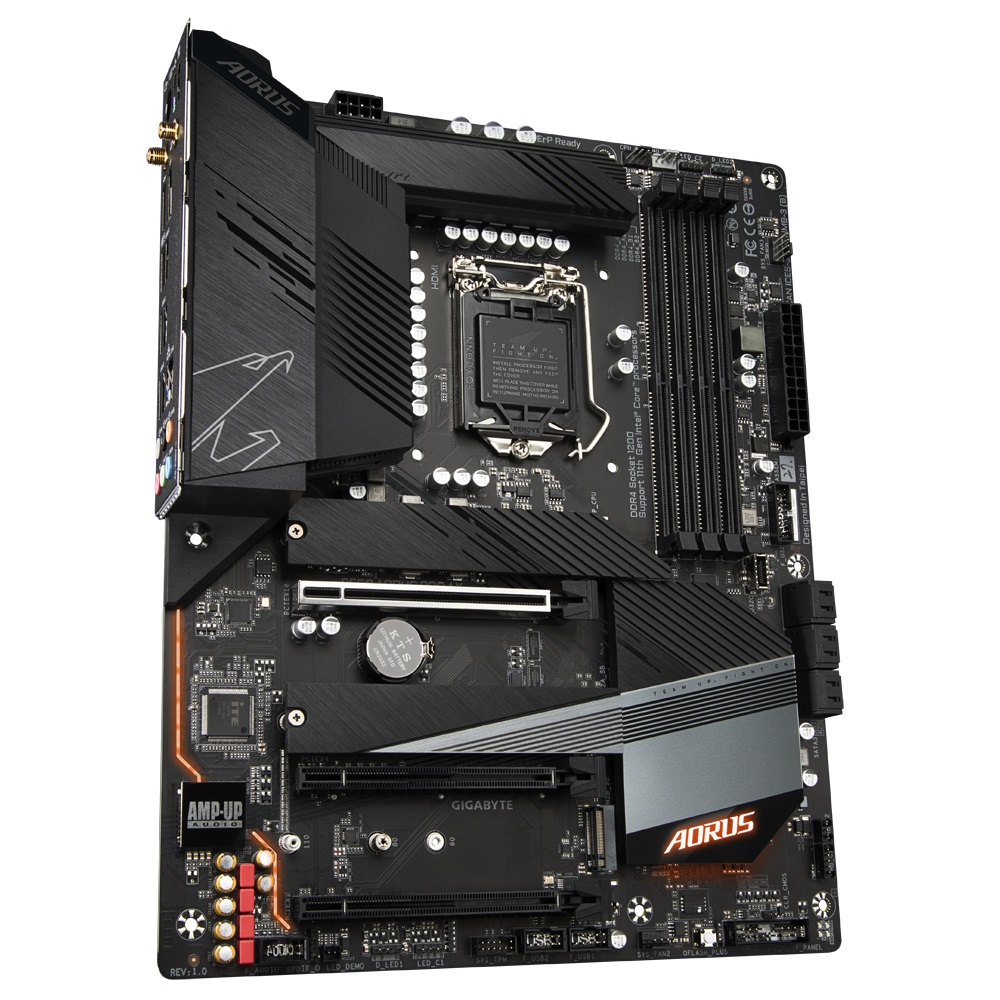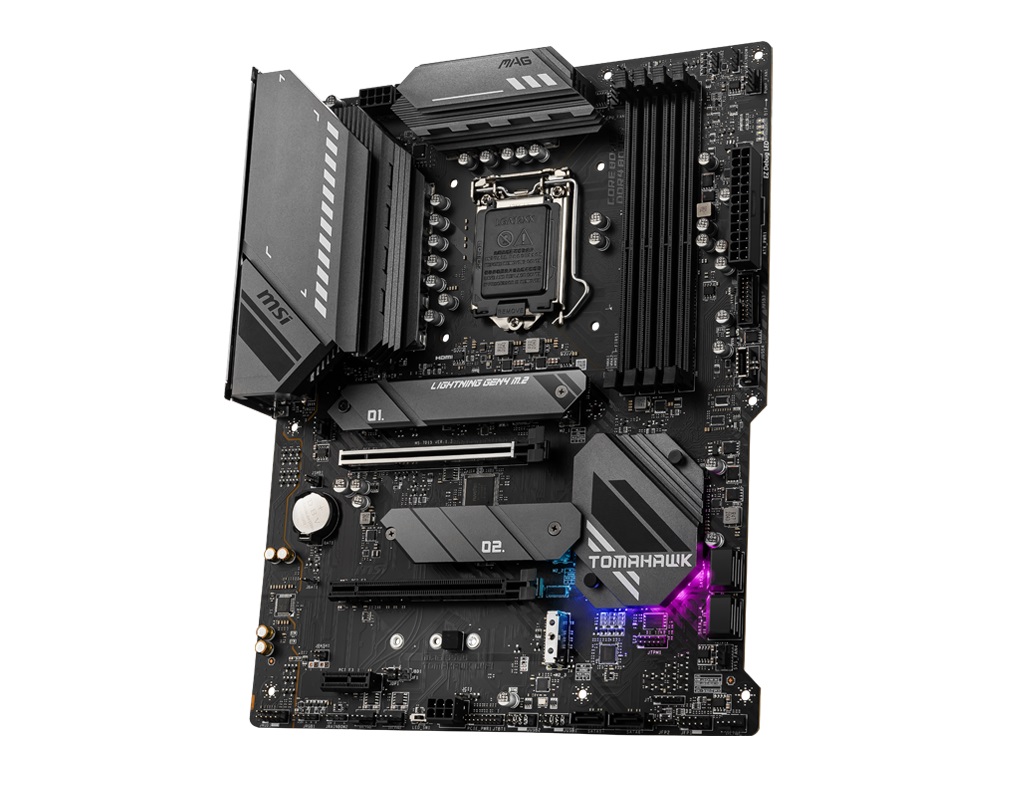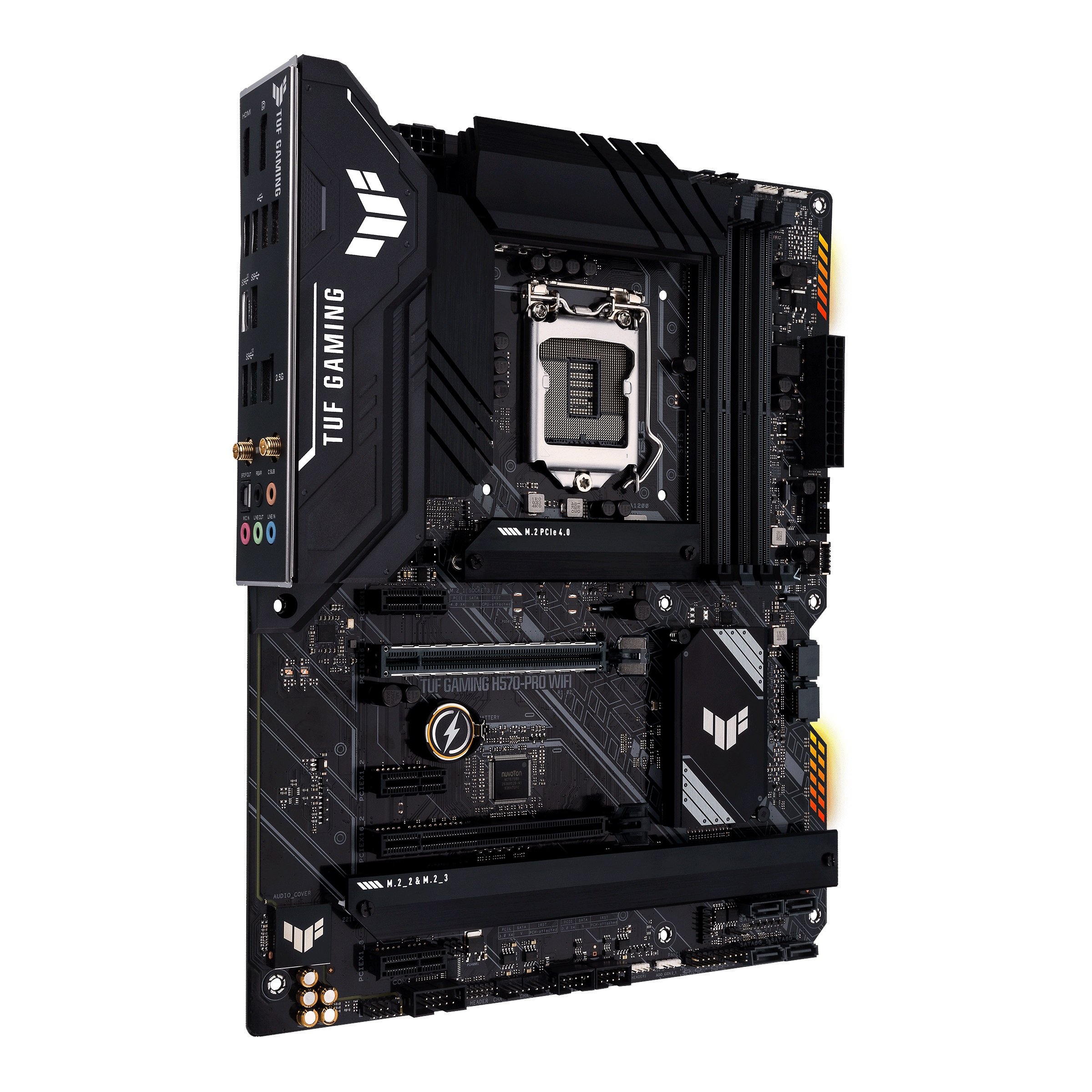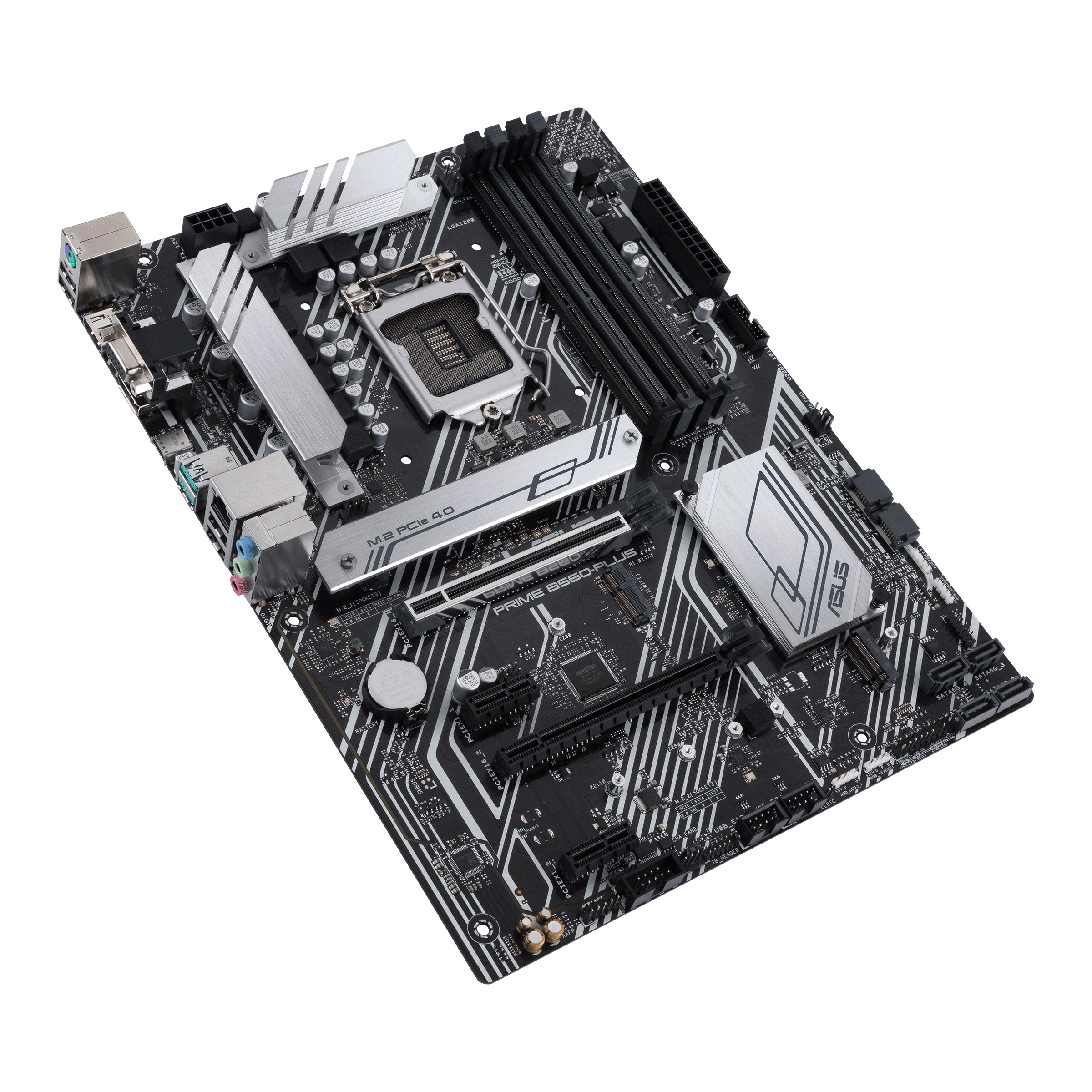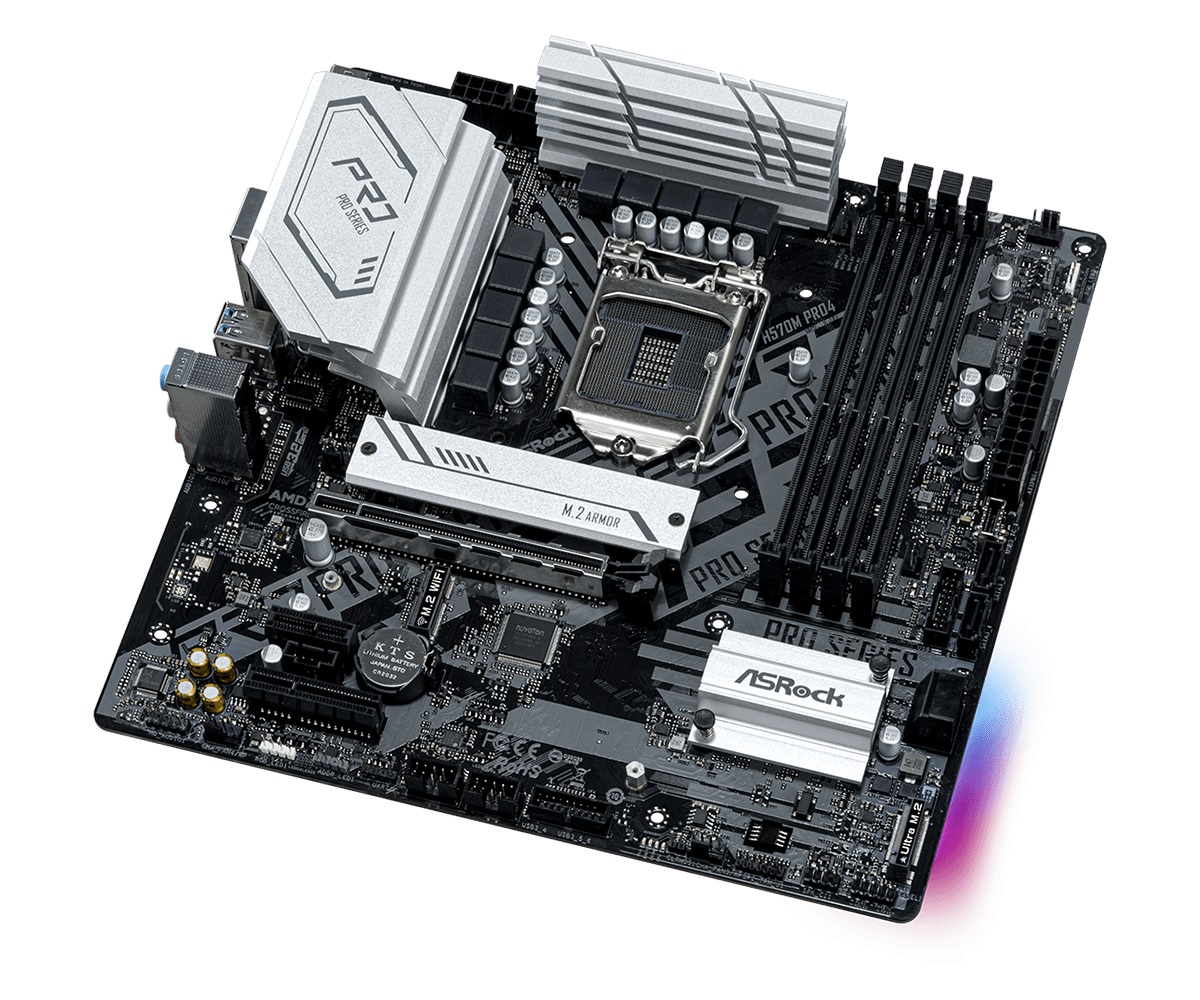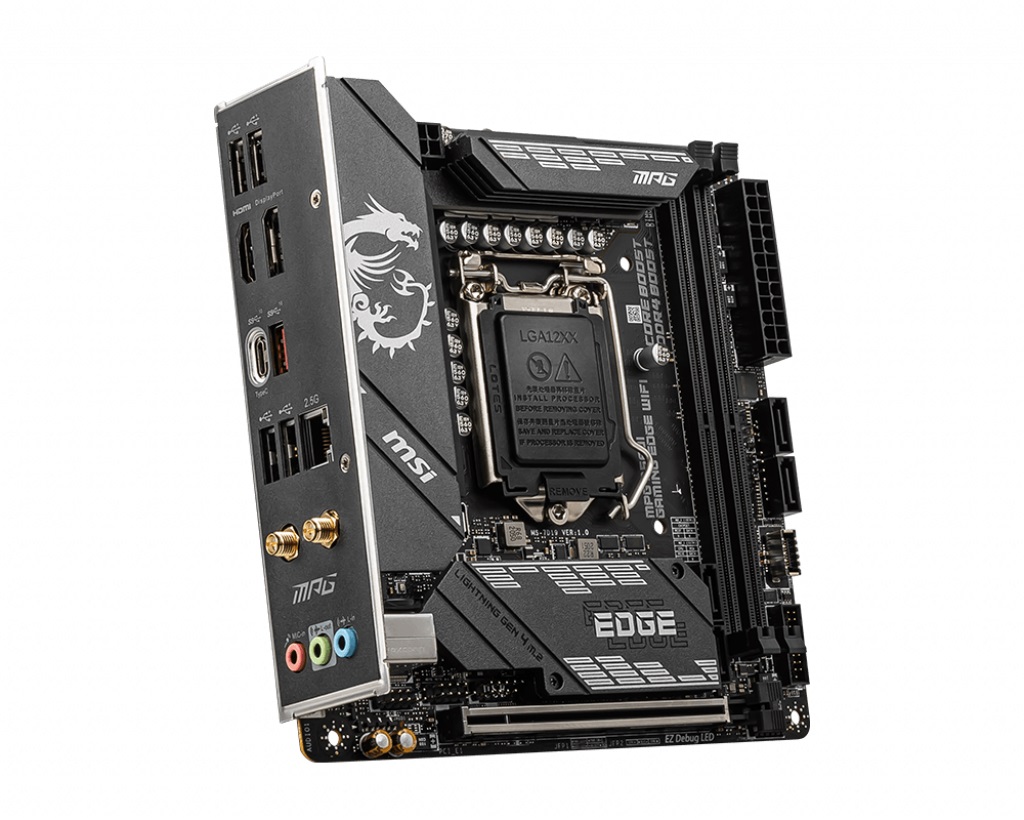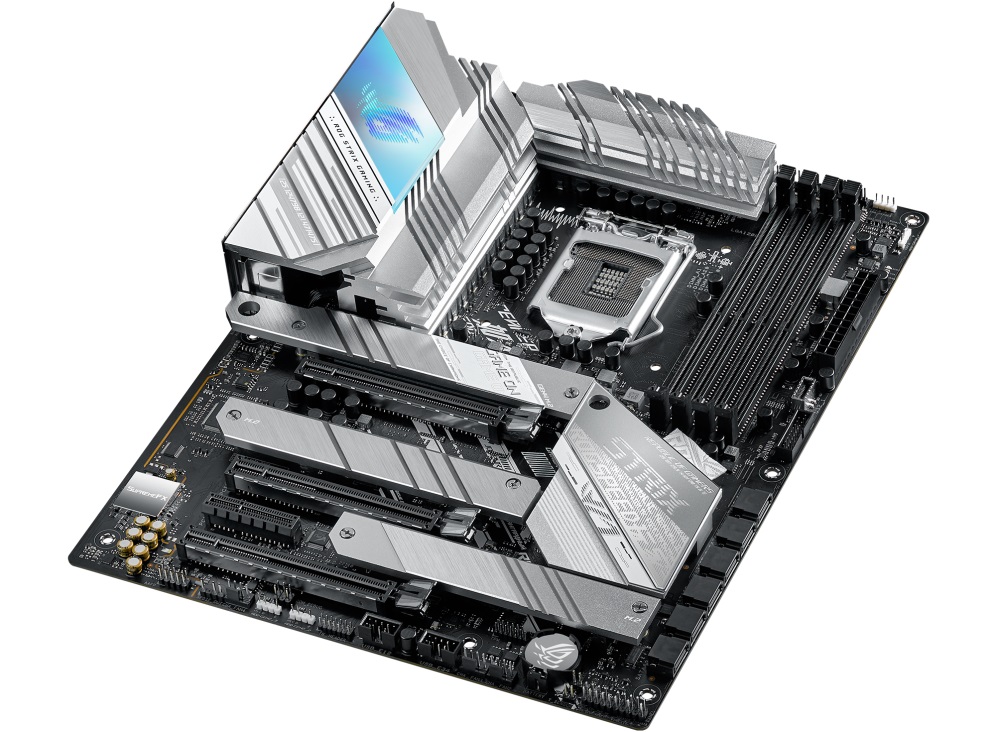In order to put these six cores and twelve threads into good use, you also require a capable motherboard that handles them seamlessly. In true essence, a Z590 motherboard is the best choice for Intel’s flagship processors. However, the i5-11400 is not overclockable and operates at a relatively lower TDP, which limits the capabilities of the Z590 to a certain extent. In simple words, a B560 motherboard is a more sensible option in terms of value for the i5-11400. You get an adequate power regulation system along with almost all the bells and whistles that the best Z590 motherboards offer, all at a much lower price point.
7 Best Motherboards For i5-11400 In 2021
With that aside, the age-old question still remains: what would be the perfect motherboard for your rig? This guide will help you answer that question by presenting the seven best motherboards for i5-11400. We’ve highlighted the pros and cons of each contender, so you’ll know exactly what’s on the table. Without further ado, let’s dive right into it. If you are unable to find an 11th gen chip and somehow you find a great bargain for the last-gen flagship processors, then we also have a detailed guide on the best motherboards for i7 10700k and i9 10900k. We’re starting off our list with a premium motherboard based on the B560 chipset from Gigabyte. The Gigabyte B560 Aorus Pro AX is a premium motherboard with all things done right.
The Aorus boards have that trademark orange color on the motherboard, be it through LED or some orange accents. The Pro AX also follows the trend and has two orange stripes at the left bottom of the board, near the audio capacitors. Furthermore, The base of the motherboard, namely the PCB is still all-black, with black heatsinks and a broad metallic gray stripe on the chipset sink that extends onto the M.2 heatsink. ‘Aorus’ is carved on the chipset heatsinks with integrated RGB LED and at the rear I/O panel, we see the classic eagle emblem. Overall, the board has a minimal black design with very subtle RGB placement which would make it a nice fit in any PC build. More Intel Motherboards: Best Motherboard For i7 8700k Moving on to the primary deciding factor of the motherboard, the performance, it lives up to the Aorus name. The 12+1 phases with 50A DrMOS are more than enough for the 11400 since it has a low TDP and is a locked chip. The cooling department is handled by two large heatsinks with 5W/mK thermal pads that work off the heat. Moreover, the left heatsink extends to the rear I/O cover, increasing the surface area for better heat exhaustion. Both the M.2 slots are also covered with heatsinks to prevent your M.2 SSDs from any thermal throttle. The B560 Aorus Pro AX hosts a dual-channel memory architecture consisting of four slots providing 128GB DDR4 capacity. The storage compartment comprises three M.2 slots, one running at PCIe 4.0 x4 and the other two operating at PCIe 3.0 x4 speeds. It is advisable to install a high-speed Gen4 SSD in the PCIe 4.0 x4 slot which you can find under our best PCIe Gen4 SSDs roundup. The M.2 slots are complemented by six SATA ports supportive of RAID 0,1,5,10. As for the primary PCIe slots, we have a reinforced PCIe 4.0 x16, a PCIe 3.0 x4 slot, and a final PCIe 3.0 x1 slot. Interestingly, all of them are full-length slots, something we’re not quite used to seeing from motherboards of this league. Another factor to a motherboard is the I/O panel or the connectivity it offers. The Aorus Pro AX’s panel is pretty well-equipped with numerous USB ports, video output ports, and also antenna connectors for Wi-Fi. It also features a USB 3.2 Gen2x2 Type-C port that has up to 20Gbps speed. Furthermore, there is a 2.5G LAN port and Intel Wi-Fi 6 for network connectivity. Audio is powered by the current-gen flagship Realtek ALC4080 codec, something we’d expect from a motherboard of this league. With that said, you can never go wrong with the B560 Aorus Pro AX from Gigabyte. Its all-round performance in every department makes it the best overall motherboard for i5-11400. When it comes to sheer value-for-money, the MAG B560 Tomahawk from MSI claims the throne. With an impressive set of features paired with a highly affordable price tag, the MAG B560 Tomahawk is the right place to put your money on. The Tomahawk series is a renowned one even among the gamers and we have also included the Tomahawk’s X570 in our best gaming motherboard lineup, due to its amazing performance in games.
We’re all familiar with this trend followed by most tech companies to deprive budget-oriented motherboards of decent aesthetics. Well, MSI has not followed the same course of action when it comes to their B560 Tomahawk. The design language, although minimalistic, provides a sleek and subtle look to the motherboard. It features a black PCB with dark grey heatsinks that are styled with silver accents. There’s the iconic Tomahawk branding on the chipset heatsink, along with RGB lighting under the heatsink. You can obviously play around with the RGB lighting using MSI’s Mystic Light software that allows you to mess with millions of color combinations. The performance is where the MAG B560 Tomahawk really starts to surprise you. We have a 12+2+1 power system with 60A stages that supplies steady and frighteningly accurate power to the CPU. This VRM configuration is powerful enough to handle the most power-hungry Intel processors like the i7-11700K, we also have Best Motherboard For i7-11700k guide, check that as well. Anyway, so handling the locked i5-11400 should be a walk in the park. The cooling duties are done by two massive heatsinks, without the presence of a heat pipe. Regardless, the thermal layout does an amazing job at maintaining temperatures; it surely is one that befits a powerful board like this one. The Tomahawk packs four DIMM slots capable of holding 128GB of RAM that can supposedly reach 5066MHz frequency speeds, which is astounding. There’s plenty of room for storage, too: three hyper M.2 slots (PCIe 4.0 x16/PCIe 3.0 x4/PCIe 3.0 x1) along with 6 SATA 6GB/s ports are present to cater to all your storage requirements. It is worth noting here that only two of the M.2 slots come with dedicated heatsinks. Coming onto the graphics department, we have a primary PCIe 4.0 x16 slot reinforced with MSI’s steel armour. A secondary PCIe x16 (x4 speed) slot and a third PCIe x1 slot are also included, both capped at Gen 3 speeds. There’s nothing too surprising about the rear I/O panel. There are eight USB ports, one of which is a Thunderbolt Type-C and four are USB 3.2 ports. You also get speedy network connectivity courtesy of the Realtek 2.5G LAN module. The standard audio stack featuring five audio jacks and optical SPDIF is provided, albeit with a substandard audio codec. The Realtek ALC897 codec is not the best offering at this price point, and MSI could have surely done better. Regardless, they’ve been generous enough to provide HDMI and DisplayPort connectivity for all our APU users out there. To sum up, the MAG B560 Tomahawk from MSI is a killer motherboard for its price. It offers that high-end user experience that earns it a very high position on the value spectrum. For this very reason, it claims the title of the best midrange motherboard for i5-11400 chipset. On the contrary, if you are not a fan of new tech and own a 6th gen processor already, check out our best motherboards for i7 6700k. Asus always manages to score a top-three spot on every other motherboard list. It is a favorite choice for almost every gamer and hardcore tech enthusiast out there. Their TUF Gaming H570-Pro WiFi motherboard is carefully designed with gaming in mind, and it is an ideal companion for the i5 11400 processor.
The TUF Gaming H570-Pro WiFi is not the prettiest looking motherboard out there, but it ticks all boxes required to look Asus-level classy. There’s a ton of TUF Gaming branding on the entire motherboard, and that includes the chipset heatsink, the rear I/O cover, the processor cover, and the PCB itself. The black PCB is complemented by massive matte-black heatsinks that look good, but perform even better. The H570-Pro WiFi is definitely not loaded with RGB; the only accents of lighting you get to see are on the right side of the board. That being said, if you want lots of bright colors or lights on your motherboard, then you might want to look at other options. Related Guide: Best Motherboard for i9-9900k The TUF Gaming series from Asus has always had incredible performance and thermals which is also the case with the H570-Pro WiFi. It hosts an 8+1 VRM solution with military-grade TUF components to ensure extreme longevity. The VRM heatsinks are pretty large and perform quite well in terms of carrying heat away and keeping VRMs cool. Asus has also thrown in three M.2 heatsinks for the M.2 slots, along with a chipset heatsink without active fan cooling. It almost seems like Asus handcrafted this board specifically for the i5 11400, as it has the right amount of power and adequate cooling performance for the i5-11400 processor. Moving on to the memory and storage section, the TUG Gaming can capacitate up to 128GB RAM at 5000MHz overclocked speeds. Out of the three M.2 slots, the primary slot supports PCIe 4.0 x4 however, only with an 11th gen chipset. Without it, the slot will be disabled. Six ports for your SATA SSDs are also included. The expansion slots follow the same pattern as the M.2, which is the primary x16 slot supporting PCIe 4.0 with an 11th gen chipset. However, instead of disabling the PCIe x16 slot, it is degraded to PCIe Gen3 with an older chip. The H570-Pro WiFi is also well-equipped in terms of rear I/O ports with a total of eight USB ports. A USB Type-C 3.2 Gen2x2 port is also provided, which is a nice inclusion. Moreover, there’s both a Wi-Fi module and a 2.5Gb LAN port for network connectivity. A DisplayPort and HDMI port is also provided for onboard display. Lastly, the audio ports are fueled by the Realtek ALC1200 audio codec. All in all, the Asus TUF Gaming motherboards have always been reliable and an excellent choice for gamers. This motherboard based on the H570 chipset is titled the best H570 motherboard for i5-11400 in our books We saw how the MAG B560 Tomahawk is a superb mid-range motherboard for the i5 11400. Bump down the budget even further and you’ll find yourself in the Asus Prime B560-Plus territory. This motherboard rules the low-end category of the market, and for very solid reasons.
There’s nothing too surprising about the aesthetics, considering the price point. We have a black PCB with silver line patterns running across the motherboard. The heatsinks are mainly brushed silver with grey accents. The chipset heatsink features The PCB is quite exposed as the heatsinks cover a relatively small portion of the board. Furthermore, there’s no integrated I/O shield and no heatsinks for two of the M.2 slots, so you might need an external heatsink for your NVME SSD. Even though there’s no integrated RGB, it’s very hard to say that the B560-Plus has a dull feel to it. However, adding some RGB fans would complement the build very well. The performance is where you really start to feel the price drop. The Asus Prime B560-Plus makes use of a 6+2 VRM configuration, which is quite underpowered. However, it is adequate enough for a low-TDP processor such as the i5-11400 that does not allow overclocking. The VRM heatsinks have a low comfort zone as well – push the CPU to its limits and you start to see those temperatures soaring, especially if your rig is subjected to humid environments. The bottom line: this motherboard gets your job done at absolute stock settings, and that’s what we’re aiming for at this price. If paired with a good airflow case and a high CFM case fan, it would produce much better results. The Prime B560-Plus supports up to 128GB of RAM overclockable to 4600MHz, which is quite an impressive number for its league. As for storage, you get one PCIe 4.0 x4 M.2 slot and another PCIe 3.0 x4 M.2 slot, along with six SATA 6GB/s ports. The second M.2 slot shares lanes with the second SATA port. The Prime B560-Plus also houses one long PCIe 4.0 x16 slot, one long PCIe 3.0 x16 slot, and two PCIe 3.0 x1 slots. With plenty of storage options and graphics connectivity, this feature set is more than enough for any average user. Asus has kept things concise in the rear I/O panel, too. We have a total of seven USB ports: two USB 3.2 Gen2 Type-A, one USB 3.2 Gen1 Type-C, and four USB 2.0 ports. An HDMI, DisplayPort, and VGA port are all provided, along with a PS/2 combo port which is quite thoughtful from Asus. The LAN module used here is Intel’s I219-V 1GbE module. The Realtek ALC897 audio codec is responsible for delivering audio through the three audio jacks and optical S/PDIF port. Again, the ALC897 is quite subpar by today’s standards, but that’s just about the best you can get in this category. In conclusion, the Asus Prime B560-Plus motherboard is the best cheap motherboard for i5-11400 out there. If you’re looking for a bit more, though, then you might want to increase your budget and go for a MAG Tomahawk or something equivalent. Grabbing the fifth spot on our list is a motherboard sporting the mATX form factor. It’s the H570m Pro4 coming all the way from ASRock, a company that’s well-reputed for creating some of the best value motherboards in the market.
An integral part of this whole sublime ASRock experience is the eye-catching aesthetics you get to see on their motherboards. The H570m Pro4 is not the best piece of art from ASRock, but they have still managed to pull a subtle look while remaining simple and minimalistic. We have an all-black Printed Circuit Board coupled with silver heatsinks featuring a brushed aluminum finish. On the bottom right-hand side of the board, you get to see their PolyChrome RGB lighting setup. ASRock has also put a lot of text on their H570m Pro4. With branding labels all over the place, you will surely never forget the identity of this motherboard The H570m Pro4 features an 8 power phase design with 50A premium power chokes which ASRock claims to provide three times better power delivery. At the top of the motherboard, we have a stacked heatsink design with inlets for better heat dissipation. There is also a heatsink for the primary M.2 heatsink, however, it can be used for the second slot as well. A small rectangular heatsink is also fixated over the chipset, to prevent it from heating. For an m-ATX board, it performs impressive, however, obviously, it doesn’t match the performance of the above-mentioned boards. It has a maximum memory capacity of 128GB that can be overclocked up to 4800+MHz speeds with an 11th-gen processor. However, it is limited to 4600+MHz when paired with a 10th-gen chip. Moving on to the storage department, it has a dual M.2 layout, with the primary slot supporting Gen4. Moreover, four SATA3 ports are also provided; however, using the second M.2 slot disables SATA_1. The storage is really limited and could be a lot better. Lastly, the provided expansion slots are one PCIe 4.0 x16, one PCIe 3.0 x1, one PCIe 3.0 x1, and one M.2 Key-E is also provided which supports PCIe WiFi modules. Being a compact and low-priced motherboard, you can’t really expect a back panel like premium ATX motherboards. It features two USB 3.2 Gen2 ports and four USB 3.2 Gen1 ports, without any Type-C ports. Further, there is one RJ-45 LAN port, one DisplayPort, and one HDMI port. Lastly, only three audio jacks are provided making use of the Realtek ALC897 audio codec. So, there isn’t a lot of versatility when it comes to connectivity but once again it provides the bare minimum. All things considered, the H570m Pro4 is quite a sweet deal from ASRock. It provides decent power and thermal performance with a compact form factor. It is the best micro-ATX motherboard for i5-11400 and would rock if paired with a micro-ATX case, which can be found under our best micro-ATX cases guide. Moving on to something a bit more compact, we have the MSI MPG B560I Gaming Edge Wifi motherboard coming in at sixth place. This is a board featuring the mini-ITX form factor, and it’s a go-to board for all the compact PC builders out there.
The MPG B560I Gaming Edge Wifi is one busy-looking motherboard, since all the components are crammed into a smaller form factor altogether. We have the LGA1200 socket sitting in the center, surrounded by chunky heatsinks. The heatsinks feature a dark grey color and have numerous logos carved on them. The rear I/O shroud has the MSI dragon logo engraved on it, which is a nice touch. You should not expect any form of RGB or Q-code LED displays from this ITX motherboard. We would recommend checking our guide on the best smallest mini-ITX cases to complete your ITX build. Mini-ITX Motherboard Guide: Best Mini ITX Motherboards for i9-9900k The Gaming Edge Wifi features a 6+2+1 VRM design with 6 phases providing direct power to the CPU. The VRMs are capable enough to handle an i5-11400 but, for a power-hungry processor like the i9-11900k though, they are underwhelming. The heatsinks are large enough for an already compact ITX board. Not only are they chunky in size, but they perform decently as well. Since the 11400 is a locked chip and has a 65W TDP, the low VRM count paired with base-level thermal performance will do just fine. An ITX form factor board always comes with limited features compared to an ATX, and it’s the same case here. It only has two DIMM slots with a 64GB capacity, however, it supports memory overclocking of up to 5200MHz speeds. As expected, the storage capabilities are also quite limited, with only two M.2 slots. However, there is PCIe 4.0 and a beefy heatsink on the proprietary slot, so that’s a plus. There is only a single expansion slot, which is the PCIe 4.0 x16. Thus, if you are fine with the bare minimum storage options and don’t want extra expansion slots, then you are good to go. As for the rear I/O ports, we have the least USB port count on this list on the B560I: six. Out of the six, four are USB 2.0 ports and two of them are USB 3.2 Gen2 (Type-A and Type-C) ports. An impressive addition is both Wi-Fi and LAN connectivity. The Wi-Fi module is also the latest Intel Wi-Fi 6E AX210. We feel the audio section could have been better, as the quite substandard Realtek ALC897 audio codec has been implemented. To sum up things, the MSI MPG B560I Gaming Edge Wifi is the best ITX motherboard for i5-11400 that money can buy. It has an overall edge over its competitors currently available in the market. One might argue that a Z590 motherboard is a bit of an overkill for a locked processor like the i5-11400. Nonetheless, the Z590 is still the flagship chipset from Intel, and it is the ultimate choice for future prospects or upgradability. Hence, we have the Asus ROG Strix Z590-A Gaming WiFi to conclude this list on a high note.
The Z590-A Gaming WiFi is based on an all-black PCB with shiny silver heatsinks all around the motherboard. Over the rear I/O cover, there are white accents that extend to the chipset heatsink and can also be seen on the first M.2 heatsink. The white accents complement the silver heatsinks quite well and give it a bold look. Moreover, the classic RGB lit ROG emblem is carved on the rear I/O cover in a light blue rectangular stripe. The stripe combined with the RGB ROG logo add a nice color to the motherboard. Since the Z590 is a premium motherboard mainly suited for premium and unlocked chipsets, it has excellent VRMs. Specifically, the VRM is arranged in a 14+2 design, which is pretty much overkill for the 11400. Not only that but the heatsinks are also large enough with grooves in them for increased airflow. Each M.2 slot has a dedicated heatsink and the chipset also has its own heatsink. Under the primary M.2 heatsink, there is also a backplate to further aid the cooling of your M.2 SSD. In short, the thermal solution is enough to handle even the power-hungry i9-11900k motherboard, however, go through our best motherboard for i9-11900k guide for more options. It features a quad DIMM arrangement that can house up to 128GB of RAM with 3200MHz native speeds (with 11th-gen processors only) and 5333MHz overclocked speeds. For the expansion slots, you are provided with three full-length PCIe 4.0 slots and one PCIe 3.0 x4 slot. There are three M.2 ports and six SATA ports with the primary M.2 slot supporting PCIe Gen4 SSDs. However, utilizing the second M.2 slot disables SATA_2 and the third slot disables SATA_6. A premium motherboard calls for a well-provided back panel with tons of useful I/O ports. Asus has always been generous with the I/O panel, especially with their ROG lineup. The Z590-A Gaming features one USB 3.2 Gen2x2 Type-C port, four USB 3.2 Gen2 Type-A ports, and five USB 2.0 ports including one Type-C audio port. It also has an Intel I225-V 2.5Gb Ethernet port and an Asus Wi-Fi module. For onboard graphics, an HDMI port and a DisplayPort are provided. Apart from that, there is a BIOS Flashback button and five audio jacks making use of the Realtek ALC4080 codec. To conclude, the Asus ROG Strix Z590-A Gaming is the most premium motherboard on this list and the best Z590 motherboard for i5-11400. It is an excellent choice for enthusiast builders or those who plan to upgrade to an unlocked chipset later.
Factors To Consider While Buying
Whenever you purchase a tech product, it is important to check whether it complies with all your requirements. Likewise, the motherboard-buying procedure is primarily based on some key factors that you should consider before dropping your money on one. In order to get the best bang for your buck, you should make sure that your motherboard of choice should tick all the boxes in the areas mentioned below.
Socket Compatibility
We’ll start off with the most basic yet important factor, the socket compatibility. All Intel Rocket Lake processors are based on the LGA1200 socket, and any other socket is completely incompatible. Even though it seems like a pretty basic thing to say, a lot of novice PC builders out there do not take this into consideration, and they end up buying a motherboard that’s just not built for their particular chipset. Don’t be that builder.
Chipset
Another vital piece of the puzzle is the chipset. The Z590, B560, and H570 chipsets from Intel are all solid options for the i5-11400. B560 hits that sweet spot (more on that later) in terms of pricing and features. The Z590, on the other hand, is a slightly expensive albeit more secure option in terms of upgradability. Moreover, Z490 and H470 motherboards also offer support for the i5-11400. However, we discourage going for a 400-series chipset, simply because the 500-series boards are much better optimized for 11th-gen processors.
Striking the balance
It is important to find the perfect balance between your needs, performance, budget, and features when buying a motherboard. If you pair a budget chip like i5-11400 with a high-end z590 motherboard, then it is overkill in both specs and money. Similarly, pairing an i9-11900k with a lower-end B560 motherboard is upright foolish since you are limiting the overclocking capabilities and also overwhelming the motherboard’s VRMs, which will damage them in the long run.
Best Motherboards for Intel Core i7-7700K (Z270) In 2022The 5 Best X299 Motherboards To Buy In 2022Best X399/TR4 Motherboards To Buy In 2022Best Mini ITX Motherboards for i9 9900k To Buy In 2022
















